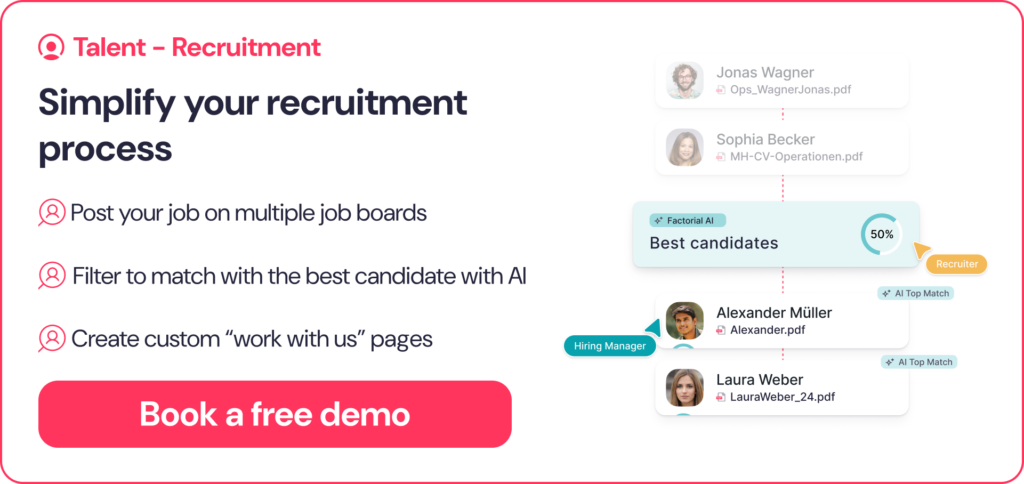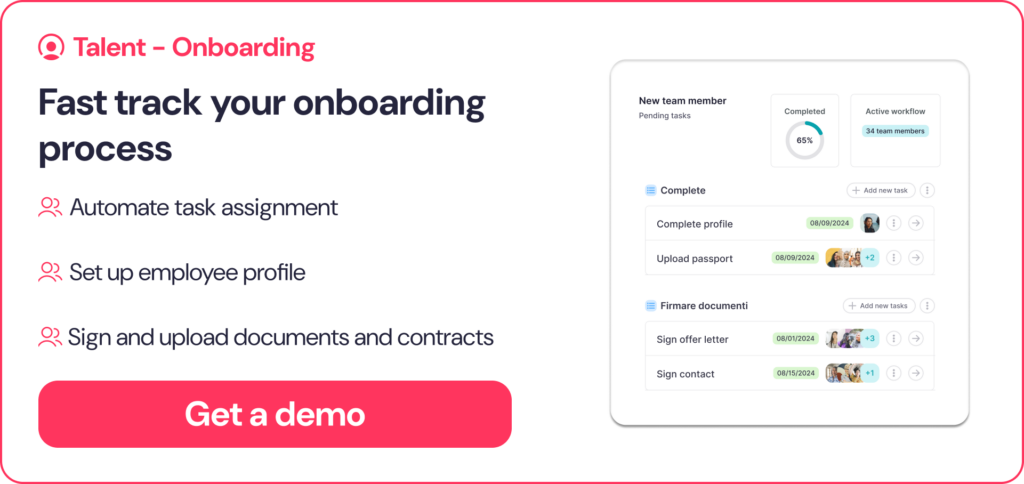The labor market is undergoing a huge transformation at the moment. There are many recruiting challenges due to economic instability, changing employee expectations, and AI. As a result, employers need to adapt their recruitment strategies in order to remain competitive and attract top talent. But these strategies shouldn’t stop at attracting the right talent – you also need to ensure you provide candidates with an efficient hiring experience. To do this, employers must decrease their time to fill so you can successfully onboard your best candidates before your competitors can make them an offer. In fact, recent studies have shown that 70% of job seekers lose interest in a job if they don’t hear back within a week from their interview. If your time to fill is too long, then it is probably having a negative impact on the quality of your workforce.
In today’s guide, we are going to discuss what time to fill is and why this recruitment metric is so valuable. We will look at the differences between time to fill vs. time to hire and take a look at time to fill benchmarks you should be aiming for. Finally, we will share a few tips to help you calculate and reduce your time to hire and convert more candidates into valuable members of your workforce.
What is time to fill?
Time to fill is a valuable workforce analytics metric used to evaluate the efficiency of your recruitment funnel. Essentially, it is a measure of how long it takes you to fill a vacancy, from the point that you open up a position until a new hire accepts a job offer. And this helps you determine how efficient your hiring process is.
The longer it takes you to advertise a position, create and shortlist a talent pool of potential candidates, and interview and hire a new employee, the longer your time to fill is. The longer your time to fill, the more likely it is that your recruitment process isn’t working as efficiently as it should.
Why is time to fill important?
Understanding recruiting metrics like time to fill is crucial for you business so you can make data-driven decision. It allows gives you insight to whether you top candidates are dropping out due to long time to fill periods. Additional benefits to time to fill are:
- Efficient recruitment process: By measuring your company’s current average time to fill a job, you’re able to plan your recruitment efforts better. If you know that the average time to fill a senior economist position is 45 days, then this allows you to start your recruitment efforts at the right time. You’re able to give your team a more accurate timeframe of how long it will take to recruit, hire, and fully onboard for this position.
- Reduced workload for your current team: If your team has a proper timeline of when a position will be filled, it will help them distribute and re-prioritize their priorities. This ensures that your current team is not overwhelmed covering for a vacant position and operating without an action plan.
- Save money on recruiting efforts: Understanding your time to fill will help you know what are the inefficiencies of your recruitment process and make changes to modify your process. This allows your business to save on recruitment efforts by decreasing the average time to fill period to ensure a vacant role is filled in a timely-manner. As paying your employees overtime is expensive as well as actively recruiting for new employees for an extended amount of time.
What does time to fill tell you
Now that we’ve gone over the time to fill meaning. Let’s discuss what valuable information you can gain from this recruiting metric. Time to fill recruiting metrics helps you to:
- Determine how efficient your recruitment process is so that you can identify potential bottlenecks. For example, you might find that your time to fill is being slowed down because you are not using the right platforms to advertise your open vacancies.
- Plan your recruitment strategies as you get a clearer idea of how long it takes to fill a position. It also makes it easier for you to plan ahead in terms of onboarding and handover procedures.
- Implement measures to streamline your recruitment process. For example, if your time to fill is too short you might discover that you aren’t asking candidates the right questions to determine if they are a good fit. And that can have a negative impact on your turnover and cause you to incur additional labor costs. Plus, hiring unsuitable candidates can also cause your revenue per employee to drop.
- Identify which positions take longer to fill and if certain departments require a longer hiring process. You can also identify which sources work best for different vacancy types. For example, you might fill admin vacancies faster when you use a recruitment agency but find more candidates for skilled positions through LinkedIn job ads.
- Reduce your chances of experiencing understaffing issues. This is a problem because understaffing can impact your productivity as a company and lead to employee burnout.
- Improve your overall candidate experience as candidates may lose interest if you take too long to get back to them after an interview.
Time to fill vs. time to hire
Before we go on, let’s take a moment to clarify the difference between time to fill vs. time to hire.
These metrics are often used interchangeably. However, they are actually very different metrics that are used to measure different aspects of the hiring process.
Essentially, it all comes down to when you start counting. The difference between time to fill and time to hire is:
- Time to fill is a longer metric. The clock starts from the moment you advertise an open position and ends when a candidate accepts your offer. This metric gives you an idea of how efficient your overall hiring process is, from start to finish. It can help you identify bottlenecks that might be slowing down your recruitment pipeline.
- Time to hire is a shorter metric. The clock starts from the moment a candidate applies for a position and ends once they come to the end of the recruitment pipeline and accept your offer. This metric is more focused on the candidate experience and how quickly they pass through your recruitment funnel. It can help you create a better candidate experience. It also gives you an idea of how effective your hiring and interviewing team is.
Calculating time to fill in your business
When it comes to calculating time to fill, there are two different metrics you should focus on: your average time to fill as an organization, and time to fill for specific roles and departments.
Let’s take a look at these two variations of the time to fill metric in a bit more detail.
How to calculate average time to fill
Your average time to fill reflects the average number of calendar days it takes you to fill a position in your company. But how exactly do you calculate this?
Let’s take a look at what you need to consider before performing your calculation.
As we mentioned already, you should start counting from the moment a position opens up. It’s up to you to determine when this point is specifically.
For example, it might be when:
- A departmental manager submits a job opening for approval
- HR or finance approves the job opening request
- Recruitment advertises a job opening
You also need to determine when you classify a position as being filled. This is usually when a candidate accepts your job offer. However, you might prefer to set the day that the candidate signs their employment contract as your fill date instead.
Once you’ve set your parameters, you can move onto your time to fill calculator.
To calculate your company’s average time to fill you just need to calculate the total number of days it has taken you to fill all open positions in a given period (such as a year), then divide this number by the total number of roles.
This is the formula:
Time to fill = TTF 1 + TTF 2 + TTF 3 / Total number of positions filled in that time period
For example, if you have hired 2 new employees over the past year, and it took you 10 hours to fill the first position and 40 days to fill the second position, then your calculation would be:
10+40 / 2 = average time to fill of 30 days
Time to fill for specific roles and departments
You can also break down your time to fill metric down by role or department. This might be useful if you have a large organization as you will get a clearer idea of how much time you need to set aside when hiring for specific positions or areas of your business. For example, it will probably take you much longer to hire a highly skilled engineer than it would take you to hire a receptionist.
By identifying how long it usually takes you to fill different roles and vacancies in different departments you get a more accurate representation that can help you better plan for future hiring needs.
How to reduce time to fill
There are a number of strategies you can implement to speed up your time to hire so that your hiring process runs as smoothly and efficiently as possible.
Here are a few examples.
Reduce hiring bottlenecks
Conduct an audit of your current hiring process and try to identify anything that might be slowing it down. For example, you might find that you are using unsuitable sources to attract talent. Or perhaps there is a lack of communication between hiring managers and candidates. Or maybe your hiring managers are taking too long to evaluate interviewed candidates. The more information you collect, and the more potential problem areas you address, the more efficient your hiring process will become.
Launch a referral program
A referral program can be a great way to speed up your hiring process. This is because you cut out the initial advertising and talent sourcing stage of the pipeline.
Essentially, a referral program is where you ask your existing employees to recommend or refer qualified candidates who could be a good match for the company. Referral programs are based on the assumption that employees generally know people with similar skills and attitudes. So, if you have a valuable employee, then their contacts are also likely to be of value.
Measure and track your recruitment metrics
Make sure you measure and track all your recruitment and HR KPIs on a regular basis so that you can gain valuable insight into each stage of your hiring process. This will help you identify potential bottlenecks so that you can improve the candidate experience and your time to hire.
Aside from hiring metrics that directly relate to your recruitment funnel, you should also monitor other more general metrics such as employee satisfaction, retention, and diversity metrics. This is important as it all has an impact on your employer reputation and, as a result, your time to fill. Check out this KPI template to see which other HR metrics you should be tracking.
Use the right recruitment technology
The tools and software you use can have a huge impact on how smoothly your hiring process runs. For one thing, you need to be using HR analytics software that helps you collect, measure and monitor all your vital KPIs, including your time to fill metrics. You also need a reliable Applicant Tracking System so that you can speed up the time it takes you to access talent pools and source candidates who would be a good fit for your open vacancies. And automating features can help you better communicate with candidates, automate interview scheduling, and speed up your screening processes. All this saves you valuable time in the hiring process.
Another advantage of recruitment software is that you get access to a hiring dashboard so that you have easy access to all the data you need at each stage of the hiring process. A hiring dashboard, like other forms of HR dashboards, is an intuitive space that you can use to keep a visual score of each candidate’s journey. That way, you can make sure you keep candidates informed at each stage of the process and reduce the overall time you spend hiring new employees. You can also use recruitment technology to automate your HR reports so that you can get a clearer picture of your hiring process and identify areas that might be slowing down your time to hire.
See how easy it is to recruit with Factorial 👇
Understanding time to fill benchmarks
It’s one thing to measure your time to fill and compare it with your metrics for the previous year. However, you also need to consider how long other companies are taking to fill their vacancies.
The Society of Human Resource Management (SHRM) reports an average time to fill of 42 days. However, it’s important to remember that time to fill benchmarks can vary greatly by industry. For example, according to a recent survey by LinkedIn, engineering jobs take an average of 49 days to fill. In contrast, positions in the leisure and hospitality industry take an average of 20 days to fill.
Generally speaking, according to Gartner’s recent Recruiting Effectiveness Survey, time to fill increased by 18% from 2020 to 2021. This means that, on average, companies are taking an extra two weeks to fill a position compared to 2020. And this delay can have a detrimental effect on any business, including lost productivity and an increase in offer rejections. This clearly highlights the growing need to establish data-driven benchmarks to help you reach your time-to-fill objectives.
Additional hiring metrics to consider
Finally, remember that time to fill isn’t the only recruiting metric that you should be tracking. In fact, there are a number of recruitment analytics metrics that you need to monitor on a regular basis.
This includes:
- Quality of hire
- Conversion rates
- Candidate experience
- Source of hire
- First-year attrition
- Applicants per opening
- Cost per hire
- Offer acceptance rate
- Selection ratio
- Time to productivity
Let’s finish by taking a look at a few of these in a bit more detail. That way, you will be armed with all the information you need to optimize your hiring process and attract and retain the best top talent in your business.
Quality of hire
Quality of hire is an HR KPI used to measure the value that a new hire brings to your organization. It helps you quantify how much a new employee contributes to the output of your business compared to pre-hire expectations. The measure is based on a variety of indicators, including retention levels and employee performance, satisfaction, and engagement levels.
Measuring the quality of your new hires is a great way to calculate the ROI of your hiring process. It’s also a great way to monitor a new employee’s performance to determine whether or not they are meeting expectations. Plus, it can help you spot any potential issues within your talent acquisition and hiring processes. This gives you an opportunity to make improvements to the candidate experience where needed. And that way, you can attract valuable, productive, and loyal employees to your business.
Source of hire
This metric helps you determine which platform or job site is providing you with the highest number of quality candidates. Are you sourcing more candidates from job boards, social media, referral programs, or external recruitment agencies?
This data then helps you make informed decisions about where to allocate your spending and efforts.
Conversion rate
Conversion rate helps you determine how many successful candidates accept your job offers once they have reached the top of the recruitment funnel. This metric can give you valuable insight into how competitive your job offers are. For example, if an interviewed candidate turns down your offer, it might suggest that the salary is too low.
If your salary is competitive, then there might be other issues in the hiring funnel. This might be down to a prolonged time-to-hire period, or a negative candidate experience.
Candidate Experience
Your candidate experience can affect a range of aspects of your business. As we just saw, a bad experience can have a negative impact on your conversion rate. It can also impact your time to fill as, if a high number of candidates are having a bad experience, it will take much longer to find someone who accepts your job offer.
Make sure you offer the best possible experience to all applicants and candidates. Communicate regularly with them and keep them informed. Measure their experience through surveys and questionnaires and address any problem areas that they raise. Send them regular updates on the status of their application. Once you have interviewed them, let them know the outcome as soon as possible. This can have an impact on whether or not they accept your job offer. And, ultimately, whether or not your time to hire is short enough to attract and hire the best candidates.




